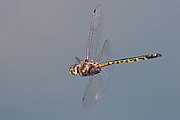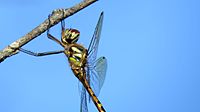Australian emerald
Appearance
(Redirected from Hemicordulia australiae)
| Hemicordulia australiae | |
|---|---|

| |
| Scientific classification | |
| Domain: | Eukaryota |
| Kingdom: | Animalia |
| Phylum: | Arthropoda |
| Class: | Insecta |
| Order: | Odonata |
| Infraorder: | Anisoptera |
| Family: | Corduliidae |
| Genus: | Hemicordulia |
| Species: | H. australiae
|
| Binomial name | |
| Hemicordulia australiae | |

| |
The Australian emerald (Hemicordulia australiae) is a species of dragonfly in the family Corduliidae.[3] It can be found in Australia,[4] Lord Howe Island, Norfolk Island, Lesser Sunda Islands and New Zealand.[5] It is a small to medium-sized, long-legged dragonfly coloured black-metallic and yellow.[5] In both males and females the inboard edge of the hindwing is rounded.[6]
The Australian emerald appears similar to the tau emerald (Hemicordulia tau).
Gallery
[edit]-
In flight
-
Female
-
Female
-
Female detail
-
Male
-
Female wings
-
Male wings
References
[edit]Wikimedia Commons has media related to Hemicordulia australiae.
Wikispecies has information related to Hemicordulia australiae.
- ^ Rowe, R.; Marinov, M. (2020). "Hemicordulia australiae". IUCN Red List of Threatened Species. 2020: e.T163871A83376811. doi:10.2305/IUCN.UK.2020-1.RLTS.T163871A83376811.en. Retrieved 20 November 2021.
- ^ Rambur, Jules (1842). Histoire naturelle des insectes. Névroptères (in French). Paris: Librairie Encyclopédique de Roret. pp. 534 [146] – via Gallica.
- ^ "Species Hemicordulia australiae (Rambur, 1842)". Australian Faunal Directory. Australian Biological Resources Study. 2012. Retrieved 28 January 2017.
- ^ "Victorian Dragonflies". www.ecology-solutions.com.au. Archived from the original on 13 July 2005. Retrieved 6 June 2022.
- ^ a b Theischinger, Günther; Hawking, John (2006). The Complete Field Guide to Dragonflies of Australia. Collingwood, Victoria, Australia: CSIRO Publishing. p. 244. ISBN 978-0-64309-073-6.
- ^ Watson, J.A.L.; Theischinger, G.; Abbey, H.M. (1991). The Australian Dragonflies: A Guide to the Identification, Distributions and Habitats of Australian Odonata. Melbourne: CSIRO. ISBN 0643051368.








